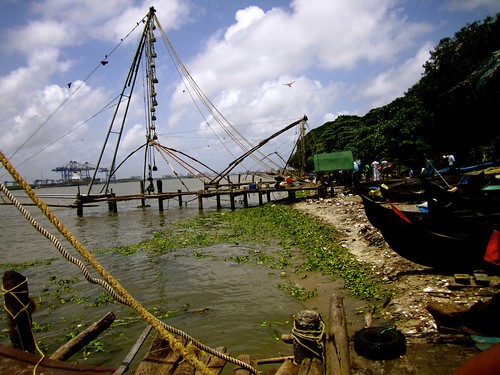 I walked toward the grey-eyed fisher, crossing two brown and white cats sprawled out on the wooden platform. Beneath my feet the wooden boards made a creaking sound. Were they safe, I wondered? I took the worn rope from the fisher’s hand, and for a moment, my body stiffened. We were about to reel in something huge. I could tell by the way the other men held to their ropes. Their legs positioned sturdily, their feet bare. I should have taken off my sandals, I thought. But it was too late. The pulling began.
I walked toward the grey-eyed fisher, crossing two brown and white cats sprawled out on the wooden platform. Beneath my feet the wooden boards made a creaking sound. Were they safe, I wondered? I took the worn rope from the fisher’s hand, and for a moment, my body stiffened. We were about to reel in something huge. I could tell by the way the other men held to their ropes. Their legs positioned sturdily, their feet bare. I should have taken off my sandals, I thought. But it was too late. The pulling began.
“Hija la! Hija la! Hija la!”
The men chanted the old fisherfolk song — a song for hard work, the grey-eyed fisher told me — as we reeled in Cheena vala (the famous Chinese fishing net). I bent my legs and employed my upper body strength, pulling down on the rope. It squealed and groaned as we tugged faster. Harder. ‘Hija la! Hija la!”
There she is. From the coast of the Arabian Sea, the mechanical sea creature of Fort Cochin emerged. Held by bamboo and teak poles, the massive shore operated fishing net stretched about 20 meters wide over the water. The net slowly revealed as we raised it higher and higher.
“Step back!” motioned the grey-eyed fisher. The large heavy rocks that hung from ropes on the contraption were coming in fast, just above my head. I stepped backwards quickly, onto the creaky platform. And then, as suddenly as it all began, the pulling stopped. The large rocks rested calmly on the platform and just a few feet in front of us was the whole of the Chinese fishing net, suspended midair at nearly 10 meters high. Her slimy trap drooled back into the sea.
The grey-eyed fisher wanted me to follow him again, to the mouth of Cheena vala. He must be mad? Even still, my curiosity forced me to trail him across the narrow wooden planks, even more rickety than the platform. I moved steadily. One wrong step could send me flailing through the air and into the murky waters. When I reached the mouth I saw clearly a small cluster of fish flopping about, wanting to be released. But only jelly fish received such luxury. The grey-eyed fisher pointed into the net. There, a tiger fish. And there, cat fish. A team of fishers at the next platform over had just caught a red snapper. He looked longingly at their Cheena vala, hoping his would be so kind the next time. Another fisher holding a blue net scooped the fish from the mechanical sea creature’s mouth, before descending her back into the water.
Her appetite is low this time of year, he told us. The month was August.
If you’re ever in Fort Cochin, you may want to see this unusual way of fishing yourself as Chinese fishing nets are mostly found in Kerala. If so, you would be wise to buy the day’s catch and have it cooked just a short distance up the street at a local food stall. It should only cost you 450 rupees for one fish — or around there. I hear it’s good. Or you can do as my husband and I and stay on the wooden platform a bit longer with the fishers. Get to know them. And every four or five minutes, when the mechanical sea creature has had it’s modest fill, you’ll help raise her up high and see what she had a taste for this time. Red snapper perhaps? If you’re lucky.

I am a Student from kochi…
happy that you wrote about our Kochi….
Nice review.
Glad you enjoyed the post Jinson! We loved Kochi–can’t wait to go back 🙂